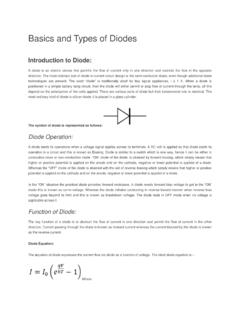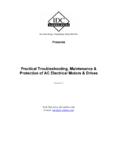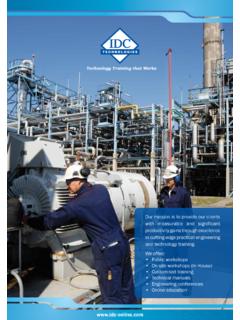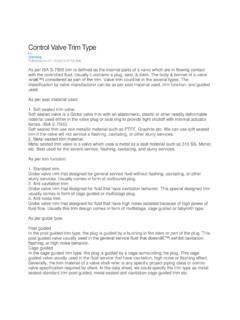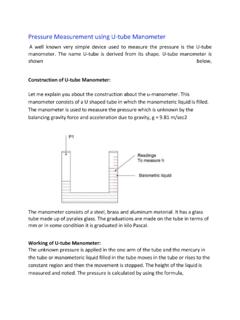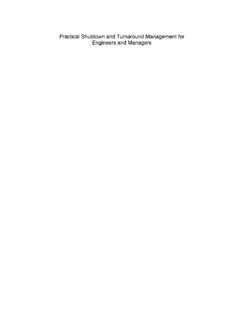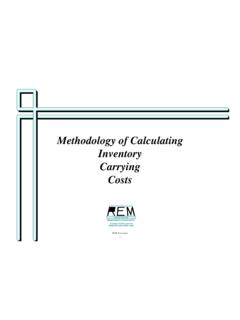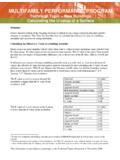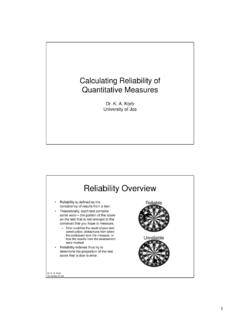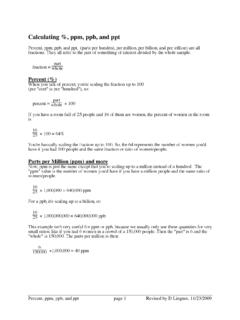Transcription of Method of calculating the cooling rate - IDC
1 Method of calculating the cooling rate This chapter describes Method of calculating the cooling rate in HAZ during welding of thick and thin plates besides that of critical cooling rate for steel under welding conditions. Further, significance of peak temperature in heat affected zone and solidification time of weld metal for development of sound weld joint has also been presented. Keywords: Peak temperature, solidification time, width of HAZ, weld structure Calculations of cooling rate Thickness of the plate to be welded directly affects the cross sectional area available for the heat flow from the weld which in turn governs cooling rate of a specific location. Accordingly, two different empirical equations are used for calculating the cooling rate in HAZ for a) thin plates and b) thick plates, depending upon the thickness of plate and welding conditions.
2 There is no clear demarcating thickness limit to define a plate thick or thin. However, two methods have been proposed to take decision whether to use thick or thin plate equation for calculating the cooling rates and these are based on 1) number of passes required for completing the weld 2) relative plate thickness According to first Method , if number of passes required for welding of two plates is less than 6 then it is considered as thin plate else thick plate for selection of suitable equation to calculate cooling rate. Since this Method is not very clear as number of passes required for completing the weld can vary with diameter of electrode and groove geometry being used for welding, therefore a more logical second Method based on relative plate thickness criterion is commonly used.
3 The relative plate thickness criteria is more logical as it considers all the relevant factors which can affect the cooling rate such as thickness of the plate (h), heat input (Hnet), initial plate temperature (To), temperature of interest at which cooling rate is desired (Ti) and physical properties of plate like (specific heat C, density ). Relative plate thickness ( ) can be calculated using following equation: h{ C(Ti To)/Hnet}1/2 Thin plate cooling rate equation is used when relative plate thickness < and thick plate cooling rate equation is used when > If value of is in range of to then is used as a limit value to decide the cooling rate equation to be used.
4 cooling rate (R) equation for thin plates: {2 k C (h/ Hnet)(Ti To)3}0 (1) cooling rate (R) equation for thick plates: {2 k(Ti T0)2}/Hnet0C/sec ..(2) Where h is the plate thickness (mm), k is thermal conductivity, is the density (g/cm3), C is specific heat ( ), Ti is the temperature of interest (0C), and To is the initial plate temperature (0C). cooling rate equations can be used to a) calculate the critical cooling rate (CCR) under a given set of welding conditions and b) determine the preheat temperature requirement for the plate in order to avoid the CCR. Critical cooling rate (CCR) under welding conditions To determine the critical cooling rate for a steel plate under welding conditions, bead on plate welds are made with varying heat input.
5 On the basis of thickness of the plate (5 mm) to be welded suitable electrode diameter is chosen first and then accordingly welding current and arc voltage are selected (20V, 200A, To=300C) for bead-on-plate (BOP) welding. Number of BOP welds is deposited using increasing welding speed (8, 9, 10, 11, ). Once the BOP weld is completed at different welding speed, transverse section of weld is cut to measure the hardness. Thereafter, hardness vs. welding speed plot is made to identify the welding speed above which abrupt increase in hardness of the weld and HAZ takes place. This welding speed is identified as critical welding speed (say 10mm/min in this case) above which cooling rate of the weld & HAZ becomes greater than critical cooling rate.
6 This abrupt increase in hardness of the weld and HAZ is attributed to martensitic transformation during welding as cooling rate becomes greater than critical cooling rate owing to the reduction in heat input (Hnet) with increase of welding speed. Using welding conditions corresponding to this critical welding speed for a given steel plate, critical cooling rate can be calculate using appropriate cooling rate equation. Corresponding Hnet = f X VI/S = X 20 X 200 /10 = 360 J/mm or kJ/mm. Calculate relative plate thickness (RPT) parameter for these conditions: h [(Ti-T0)C/Hnet]1/2 : RPT suggests use of thin plate equation for calculating the cooling rate: 2 k c(h/Q) (tc-to)3 cooling Rate (R): 0C/s and it will be safer to consider CCR: 6 0C/s Similarlyidentifyingiven PThe welrate as fPeak temweld poand so mVariationdistributinput byincreasedistributIncreasedistributFig.
7 Heat affboundar(hence peak teboundarequationy these eqng the prehet of weldingPeak temped thermal cfunction of tmperature dol, b) size mechanicaln in heat iion on the y increasines the peakion equal ae in weldiion) of tear 1 Effect ofature from the pfected zonery becomesmechanicaemperature ry for singln. 1/(tp-to) =quations caheat tempeg conditionerature andcycle of a ptime apart fdistributionof heat aff propertiesnput and iplates along the weldk temperatuaround the ng speed rdrop shapef welding ppeak tempee. Therefors of great eal properties(Fig. pass ful( chY an also beerature to as. d Heat Affearticular locfrom other f around thefected zone of weld aninitial plateng the welding currenure of a pawelding arhowever e (Fig.))
8 Detere, peak teengineerings) at a po2). Peak tll penetrati/ Hnet) + (1/e used foravoid CCR ected Zonecation exhibfactors. e weld-cente and c) typnd HAZ. e temperatuld line durnt (for a garticular locrc (almost cmakes the1). s on weld ermines finmperature importanceint near futemperatureon weld ca/(tm-to))..r calculatinfor a partice bits peak tetre line detepe of metaure affectsring weldingiven weldation and mcircular or e weld popool profileal microstrin the regie as metallsion bounde at any an be the coocular locatioemperatureermines a) allurgical trathe peak g. An increing speed)makes the oval shapeool (peak e as dictatructure of thion close tlurgical trandary are inpoint nearculated oling rate oon under -ae and coolinshape of thansformatiotemperaturease in hea) in generatemperature weld pooltemperaturted by peahe weld ano the fusionsformationnfluenced br the fusiong followin(3) or a-ng he on re at al re l).
9 Re ak nd on ns by on ng Where ttemperaof HAZ i Fig. weld jThis equthe fusioeffect onobservaheat inpand so wTo calcucritical tmetal wsteels atemperaHAZ widtreatmenthe structemperinA singleJ/mm3 temperatp is peak ature in C, in mm and 2 Schematijoints (S Kouation can on boundarn initial plattion of equput will increwidth of heaulate the witemperatureill be affectre subjecteature, hencdth becoment whenevecture and png temperae pass full C, t=5 matures at is net c is volumic showing ou, Weldingbe used fory, b) estimte temperatuation reveaease the peat affected idth of HAZe above wted by apped to metalce temperaes 727 heated tproperties aature (3000 Cpenetrationmm, tp=250 mm and 1ure in C, theat input, metric specirelationshipg metallurgyor a)
10 Calculamating widthture/preheaals that an eak temperzone. Z, it is necewhich microlication of wllurgical trature of inte Similarly, o a temperare affectedC) becomesn weld pas5 C, tm= mm andto is initial J/mm, h isfic heat (J/mp betweeny, 2003) ating peak h of heat-afating and heincrease inrature at y dssary to meostructure welding heansformatioerest/ critica steel temrature abovd hence fos the criticass is made 510 C, Q=d 0 mm disttemperatus plate thickmm3 C). Fe-C diagrtemperaturffected zoneat input onn initial platdistance froention the tand mechat. For exan above 72cal temperampered at ve 300 0C, or quencheal temperatuon steel p=720J/mm. tance from re in C, tkness in mm ram and diffre at a poinne and c) sn width of Hte temperaom the fusiotemperatureanical proample, the 27 0C lature for ca3000C afteit is over-ted and temure.
